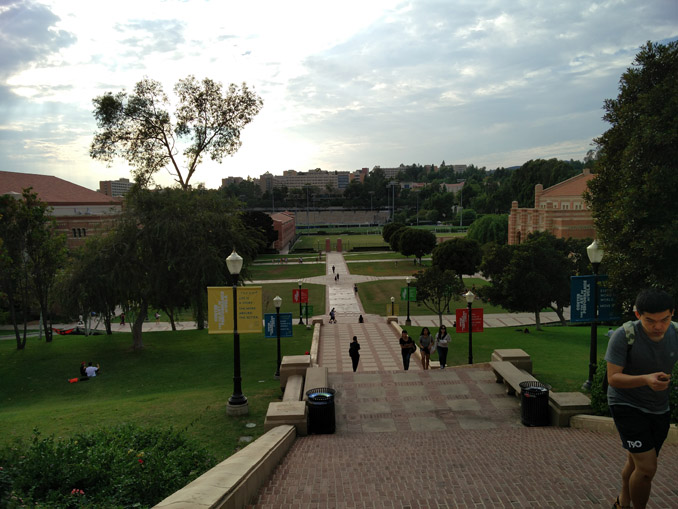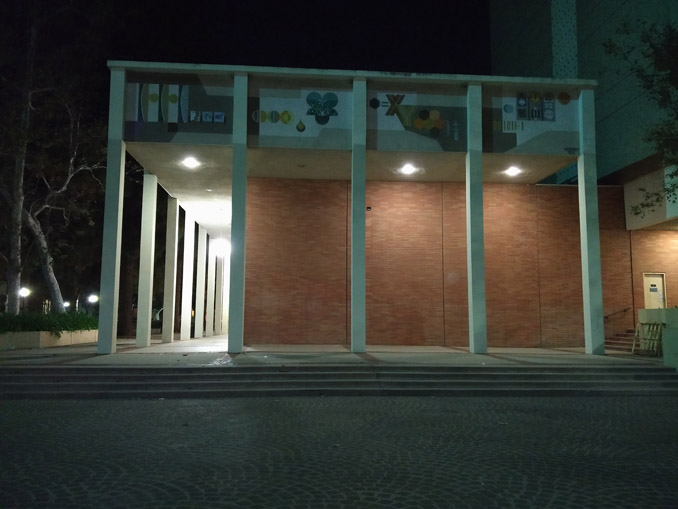The OnePlus 2 Review
by Brandon Chester on December 14, 2015 8:00 AM EST- Posted in
- Smartphones
- Mobile
- OnePlus
- OnePlus 2
Camera Architecture
When the OnePlus One was released one of its most notable features was its camera. At its price, being able to include Sony's IMX214 camera sensor was quite notable. This time around OnePlus is playing in a higher price bracket, and the stakes have been raised due to greater competition. With that being said, the camera is definitely one of the areas I see executed poorly on many non-flagship phones, either due to a poor camera sensor, or more frequently, a poor ISP and inadequate image processing.
| OnePlus One | OnePlus 2 | |
| Front Camera Resolution | 5MP | |
| Front Camera Sensor | Omnivision OV5648 (1/4", 1.4µm) |
|
| Front Camera Aperture | f/2.0 | f/2.0 |
| Rear Camera Resolution | 13MP | |
| Rear Camera Sensor | Sony IMX214 (1/3.06") |
Omnivision OV13860 (1/2.6") |
| Rear Camera Focal Length | 28mm eff | |
| Rear Camera Aperture | f/2.0 | |
The OnePlus 2 retains the OV5648 front-facing camera from the OnePlus One, along with the same lens arrangement. The rear camera now uses an OmniVision sensor as well, which is a departure from the Sony sensor used on the OnePlus One. While some may see this as a downgrade due to Sony's reputation as a great camera sensor manufacturer, I don't think there's any inherent downgrade in moving to an OmniVision sensor. On top of that, we're actually talking about an increase in sensor size from a 1/3.06" format to a 1/2.6" format, which represents a move from 1.12 to 1.3 micron pixels. These aren't as large as those found in a device like the Nexus 5X, but they're larger than the standard 1.12 micron pixels used in the sensors for most flagship smartphones. OnePlus's decision represents another OEM deciding to increase pixel size to improve sensitivity rather than increasing spatial resolution.
Still Image Testing
Due to some less than optimal weather in my area I'll be using the photo comparisons that Josh has taken for his reviews when evaluating the OnePlus 2. In a way this is good, as it means that the OnePlus One is available for comparison, which is a very relevant topic in this circumstance due to its issues with image processing. However, it does mean that the Nexus 5X isn't available in the comparison, which is an unfortunate but worthwhile compromise in this case.
To begin, I'll start with discussing the image quality when taking photos in the daylight with the OnePlus 2, followed by looking at how it fares during the night.
| Daytime Photography |
When taking photos during the day, the OnePlus 2 exhibits some improvements over its predecessor, but some regressions as well. The OnePlus One had some notorious processing issues, and one of the most prominent was how chroma noise would be plainly visible even in scenes with ample lighting. In this scene one can notice that the noise across the frame has been reduced dramatically. While this is good in a sense, OnePlus seems to have gone a bit overboard. Looking at the grass and the textures of the walkway one can see that the amount of detail is reduced compared to the OnePlus One. This is easily visible in the grass, where the heavy noise reduction has turned it into a featureless green smear.
As far as sharpness goes, the OnePlus 2 is definitely an improvement over the OnePlus One in the areas where noise reduction hasn't caused havoc. Examining the tree in the top left of the frame makes this quite apparent, with the OnePlus 2 maintaining the sharpness of the individual branches, and the OnePlus One producing a much fuzzier rendition.
Overall, if I had to choose between the OnePlus One and the OnePlus 2 as a day time camera, I would probably go with the OnePlus 2 simply due to the fact that the chroma noise in the photos taken with the OnePlus One is incredibly distracting. OnePlus definitely has room to improve their processing by toning down the noise reduction a bit in order to better preserve the detail of leafy foliage and grass. I think that phones like the Nexus 5X that offer better image quality at this price point, but they come with their own caveats as well such as having to use HDR+ mode on the Nexus 5X which greatly lengthens the capture time.
| Low Light Scene 2 |
In night time photography the OnePlus 2 makes further gains over its predecessor. When looking at the shot it's immediately obvious how much more detail is retained on the OnePlus 2, and there's none of the distracting chroma noise and smearing that exists in the OnePlus One's photo. When comparing the OnePlus 2 to other smartphones it becomes clear that it's not as good as the latest flagship devices like the Galaxy Note5 and the LG G4, but it still ends up being fairly good, and bests smartphones like the iPhone 6.
It's clear that OnePlus was aware of the problems with image processing on the OnePlus One, and the quality of photos taken with the OnePlus 2 is much better. They definitely have room to improve by toning down noise reduction which would allow them to preserve more fine details in foliage, but as it is now the camera still outputs fairly good images for a phone of this price.
Video Recording
The OnePlus 2 offers three modes for recording video. There's a 720p mode, a 1080p mode, and a UHD mode. I'll just be focusing on the latter two, as at this point almost no smartphones offer any additional benefits by recording in their 720p mode other than smaller file sizes in return for lower quality.
When recording UHD video, the OnePlus 2 puts up a notification letting you know that the capture time is limited to ten minutes. I'm glad that OnePlus, like most vendors, has thought to do this so you don't run into situations where your video stops recording without you even knowing like can happen with the new Nexus phones. As for the video itself, it's a 42Mbps 3840x2160 file recorded at 30fps, with a 96Kbps stereo audio stream. The video is encoded using the H.264 Baseline profile, which makes the OnePlus 2 another device in a trend of Android phones that use an H.264 profile that can't take advantage of space-saving features like B-frames and CABAC which would allow for smaller files or higher bitrates at the same file size.
The video is adequate from a pure visual quality perspective, but the visibly changing FOV and jerky motion caused by the use of OIS for stabilization is very difficult to overlook. It surprises me that almost every smartphone manufacturer continues to implement OIS video stabilization in such a simplistic manner, as it makes the video quite unpleasant to watch.
As for the 1080p video, it's a 20Mbps H.264 baseline stream with the same audio encoding as the UHD footage. Since you're not really gaining anything as far as stabilization goes due to the jerkiness of the footage when the OIS resets, I would stick to the UHD recording mode unless you need to record footage longer than 10 minutes in length, or if you want to save space. I suspect that most buyers will be purchasing the 64GB model of the OnePlus 2 where this won't pose a problem anyway.












132 Comments
View All Comments
Cow86 - Monday, December 14, 2015 - link
I really wonder if there isn't anything wrong with your Oneplus 2 Brandon, I've just been going over some reviews from other sites, and they all seem to be very happy with the phone, both on the performance side and the screen. That being said, most don't look at the screen as detailed as you guys do, but they all call it pleasant, vibrant, if a little blue, and things like that, and the general performance with browsing etc never really seems to be an issue. At the same time, their battery life is pretty poor. It seems to indicate that in most other cases the A57 cores are getting used where with your phone they aren't...That all being said, not a phone for me either way, but I figured I'd just point to the discrepancy.
Brandon Chester - Monday, December 14, 2015 - link
I actually think the display discrepancy is actually a good example of how sites that do those very superficial evaluations tend to be wrong about most aspects of a device. A good example is how some reviews parrot the PR line that S808 is perfectly fine despite us having published data showing that it is not. Another example is the mind boggling complaints of the Nexus 5X display being dull or washed out, when it's actually incredibly accurate and covers its target gamut.Ryan Smith - Monday, December 14, 2015 - link
And part of the issue is that the human visual system is absolutely terrible about accuracy.For as well as we can see, we are easily tricked by bright colors. Most people will find a bright, oversaturated display to be better. Which if that's what they like, that's fine. But it's not desirable as a stock setting on a phone since it causes shared media to be displayed inaccurately.
Cow86 - Tuesday, December 15, 2015 - link
All fair points, and I do agree I wouldn't trust most other sites to be more than subjective comparisons, but at the same time I do wonder how they can say the performance is smooth when your phone clearly was not (which by the way was the main point I was trying to make, I should've put that first and not the screen issue :P). Then again, 'smooth' is subjective as well. My Moto G 2013 is considered smooth by me most of the time...*shrug*grayson_carr - Monday, December 14, 2015 - link
I dunno. I have owned a lot of phones this year as an Android developer and tech enthusiast and I did feel that the OnePlus 2 underperformed compared to other phones with the Snapdragon 810 and even 808.K_Space - Monday, December 14, 2015 - link
I couldn't agree more. I had an OPO which I bought quite late in 2015 by which time most custom ROMs matured a fair bit. I ended up getting a quick invite for the OPT having attended their launch event almost by chance. The OPO made its way to a family member but I had a chance to play with both for quite a while. Not only do I find the SoC a lot less responsive but the OS is SERIOUSLY lacking in terms of features. Having never used Oxygen 1.0 and moving straight to an 'unofficial' Temasek ROM from CM 11.0 the OP2 truly feels like regression. To add insult to injury, as far as I know OPO still hasn't received Oxygen 2.2 (setteling for that trend that plague other manufacturers of no support for older phones). OPO was a great phone which seriously disrupted the market and forced the hands of other companies to raise their game in the bangs for bucks category. OPT was merely hoping to float on the hype of its predessecor. I'll be waiting for the more mature custom ROMs to land and hopefully that will bring some shine into the phone.zeeBomb - Monday, December 14, 2015 - link
Wow... This review surprised me. Dropped outta nowhere, but I find this device disappointing compared to it's predecessor.zodiacfml - Monday, December 14, 2015 - link
Ouch.bruh123 - Monday, December 14, 2015 - link
im not saying that the phone isn't cool im just saying the price is tooooo mucheddieobscurant - Monday, December 14, 2015 - link
Will you review the oneplus X ?